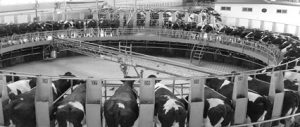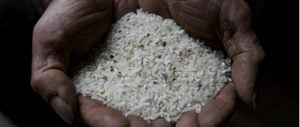For the last three decades, China’s factories have turned out goods for export markets, while Chinese citizens have paid the environmental price of industrialisation in the pollution of their air and water and in the contamination of their land. But as China’s citizens grow richer and more concerned about the impacts of pollution on their health, there are signs, in one sector at least, that this pattern could be reversed: China’s growing demand for certain kinds of imported food is causing concern about pollution in producer countries.
The United States is the world’s largest food producer and China is rapidly becoming its biggest customer. In the three years to 2009, China’s food imports from the US more than doubled and in that year the United States sold more than US$13 billion worth of food to China, putting China second only to Canada as a customer for US agricultural products.
A number of factors are driving China’s appetite for imports: a wealthier population is spending more on larger quantities and a better quality of food, and successive food scandals in China have heightened fears about the safety of home-grown produce. At the same time, China’s own animal husbandry is scaling up, creating more demand for imported soy beans and corn to feed a growing volume of livestock. In a relationship sometimes troubled by trade disputes and geo-strategic rivalries, the US-China trade in food and agricultural products is quietly thriving.
But two concerns could upset this otherwise peaceful relationship: in the longer term, the future of US food production is itself threatened by climate change; and in the short term, the environmental impacts of the farming practices that underpin US exports to China are under critical scrutiny from American environmentalists.
This is particularly true in the pig meat trade. China is predicted to import some 1.4 million tonnes of pork in 2012, up from 1.1 million tonnes in 2011, or around 2% of the total pork consumed in China. China is, of course, a major pork producer itself, but outbreaks of disease among China’s pigs have affected supply, and since 2007 China’s pork imports have been rising steeply: in the first four months of 2012, US pork exports to China were up 142% over the same period in 2011.
Ironically, domestic consumption of pork in the United States has been declining since 2008, but production remains buoyant, largely because of the thriving export market. And while Chinese consumers see imports as a safer option than home-grown food, US environmentalists are increasingly critical of the environmental impacts of the factory farming methods that now dominate US pig production.
The advantages of industrial-style production, in which pigs are tightly packed in cages in giant production facilities, is that the economies of scale have lowered costs to the point that it costs half as much to produce a pig in the United States as it does in China. Environmentalists, however, point out that everything has a price: they are concerned not only about animal welfare, but also, perhaps more worryingly, with pollution and disease.
The drugs used to contain disease in tightly packed and highly stressed animals can constitute a hazard to human health; and with production concentrated in large units, live pigs are shipped long distances to market, risking the spread of disease to new populations. Industrial units have been highlighted for the noxious waste they produce and the hazards they present to local environments.
Industrial production now accounts for 97% of US pork; China, by contrast, still produces 80% of its pigs in small- or medium-sized facilities. Critics of the trend towards industrial scale pig farming point to the outbreak of “swine flu” in 2009 when H1N1, as the strain was known, caused international alarm with high infection rates, before vaccines were developed. The epicentre of the outbreak, in La Gloria, Mexico, was close to a factory that produced a million pigs a year and was owned by a subsidiary of the US pork giant, Smithfield Foods. Although the outbreak was never sourced to the factory, analysis of the virus strain suggested that its ancestors originated in the United States.
Thousands of miles away, in Scotland, another factory farming venture recently boosted by China’s appetites has also raised environmental anxieties. The pristine sea lochs of Scotland’s west coast mainland and its offshore islands are favoured sites for salmon farming. The industry is strongly supported by the Scottish government as a provider of jobs in remote areas, but it has been fiercely criticised by environmentalists for polluting otherwise pure marine waters.
Overcrowded fish cages require large quantities of chemicals to contain disease and they produce large volumes of waste. Critics also complain that escaped fish inter-breed with the wild Atlantic salmon that return each year from thousands of miles away to breed in their native rivers, and that infestations of sea lice in fish farms along their migratory routes spread to, and kill, the wild fish.
Concerns about the impacts of commercial fish farming were heightened in January 2011, when China opened its markets to Scottish salmon. The Chinese vice-premier Li Keqiang, visiting Scotland in 2011, reportedly told the Scottish first minister, Alex Salmond, that if only 1% of Chinese ate Scottish salmon, production would have to double. The news did not please everybody: many critics believe that fish farming is unsustainable because of the huge volumes of wild fish they require to feed the farmed salmon and the pollution the farms cause.
Scotland’s fish farms had become the beneficiaries of a political dispute between China and Norway that had led to the collapse of Norwegian salmon sales to China. As it happens, the Scottish salmon farming industry is overwhelmingly Norwegian owned, but it is the impact on marine life that concerns Scottish conservationists, rather than who owns the fish farms.
Earlier this year, the Scottish Salmon and Trout Association, which lobbies on behalf of anglers for the protection of valuable wild fish stocks, reported that chemical use and lice infection rates were both rising in Scottish fish farms. This suggested, they said, that sea lice were developing resistance to the chemicals used. Commercial shell fishermen are also concerned about the impact of increased chemical use on local populations of crabs, lobsters, prawns and shrimps. Farmed fish exports, they point out, may be valuable, but if the price is paid by other species, it could prove a bad bargain.
Isabel Hilton is editor of chinadialogue.
Homepage image by Annette Schwindt




